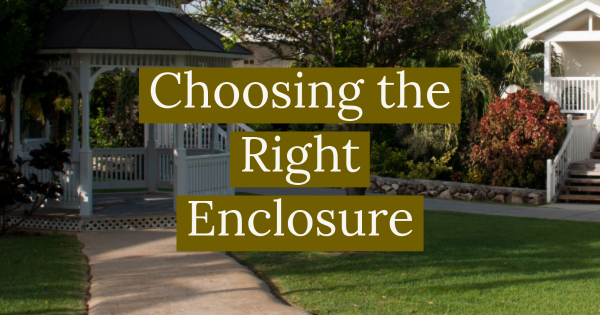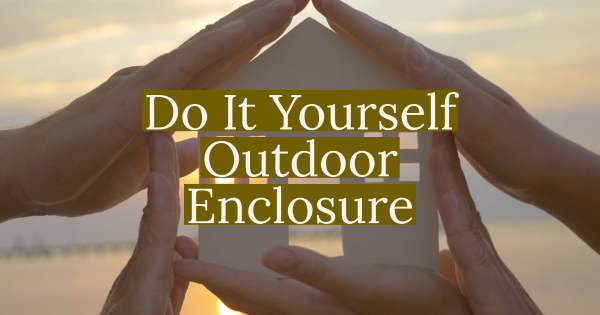
There are so many ways to build an outdoor enclosure, but most important of all is how much you’re willing to spend and what exactly you need it to do.
If you plan to spend a lot of time outdoors, with family and maybe friends, then you’ll need adequate space, but if it is just for your pet/s, then a tiny DIY project will suffice.
Here’s a simple, cost-effective way to build a DIY outdoor enclosure and how to add whatever features you desire with suitable building materials without breaking the bank.
Outdoor Enclosure Costs

Most homeowners spend between $9,500 and $16,000 on average across the United States when building an outdoor enclosure for their patios.
This cost can be significantly lower if you choose to do it yourself, but only if you already have the requisite skills or follow instructions keenly. Looking at the figures from minimum to maximum cost would be 500 dollars and 34,500 dollars respectively.
The Essentials for a Do-It-Yourself Outdoor Enclosure

- Safety glasses
- Stepladder
- Miter saw
- Level
- Stapler
- Chalk line
- Saw with a circular blade
- A cordless drill
- Set of drill bits
- A hammer
- Protection for your hearing
- Mason’s line
- Saw with a reciprocating blade
- Scaffolding.
- Set of sockets and ratchets
- Stapler with a square speed
- A table saw
- Measurement tape
- Snips made of tin
- Utility tool belt and knife
As many homeowners believe, the size of the patio is the most critical factor influencing the project’s expense. It would be much less costly to enclose a 300-square-foot patio than it would be to enclose a 1,000-square-foot terrace.
Not only are more materials required, but the designs often become more complex, and the project takes longer overall. As a consequence, a patio enclosure’s average cost is higher.
Choosing the Right Enclosure

There are a few different styles of patio enclosure available. The first and most common choice is a traditional roof. The cost of an enclosed patio is similar to the price of a conventional roof enclosure.
Awnings, on the other hand, are a better investment. Screens are used by homeowners to cover the patio’s sides. As you would imagine, screens are not as solid as actual walls or a roof. As a result, awnings are far cheaper than traditional roof enclosures.
Windows will account for a large portion of the overall cost if you choose a conventional enclosure. If you live in a colder climate or an area with a lot of noise, you’ll need strong and sturdy windows for your patio cover.
Furthermore, some areas can need double-glazed windows for better insulation. These high-quality windows are usually more expensive.
Screens are much less expensive, but they only defend against bugs and debris. Patio builders use meshes often in climates that are typically mild or hot.
Permissions Are Needed

Although not all cities need patio enclosures (or patios in general) to be permitted, the majority do. Consequently, if you’re trying to find out how much a new patio enclosure would cost, you can go to the local construction department for help.
Treat these licenses with great care. If you build a patio in a city that requires them, you risk receiving a fine or, worse, getting an order to remove your patio when all you wanted to do was cover it.
Decorative Elements
With each addition, you must strike a balance between form and function. The higher the design standard, the more expensive the project. The same is true when it comes to putting up a patio cover.
Any changes to the decor would increase the total cost. Adding a skylight, window treatments, unique paint colors, glass doors, or other design elements to your patio will raise the total cost.
The Price of a Covered Patio
Is the use of awnings better than patio roofs?
As you’ve just learned, the type of enclosure you select has a significant impact on the overall cost.
Even though patio roofs are more common, many homeowners are reluctant to spend the money on a full enclosure and instead opt for an awning and screen. Some homeowners in hot climates don’t even bother with the screen.
However, before making a final decision, it’s essential to consider the benefits and drawbacks of both options.
Benefits and Drawbacks of a Patio Roof
Patio roofs are the safest and most long-lasting choice available. Traditional patio enclosures will keep you warm in the winter while also protecting you from rain, snow, leaves, and insects. Furthermore, as compared to an awning, a patio roof adds more value to your house.
Of course, there are several drawbacks. Awnings and screens are considerably more expensive to fix and install than complete patio enclosures. Furthermore, unless you buy a retractable enclosure, you will never be able to take it down except on the nicest of days (which is very expensive).
Awnings’ Advantages and Disadvantages
Roofs are significantly more costly than awnings. An awning installation in the United States costs about 2,000 dollars. When you calculate the cost of windows, the patio enclosure can cost no more than $3,000.
Awnings are suitable for those who live in hot climates. Awnings also provide shade for their owners. You may not be able to get a glass enclosure or glass door.
Awnings and windows, on the other hand, do not last as long as fully enclosed roofs. They won’t keep you dry in the rain or protect you from powerful winds. Finally, they have no discernible effect on the value of your home.
Windows vs. Screens for Patio Enclosures
A patio enclosure’s windows are a significant expense. Windows allow you to get some fresh air as well as let in the necessary light to illuminate the room.
Some homeowners, however, will need strong windows to withstand high winds, rain, and snow, as previously reported. Double-glazed or storm windows are a must if you live in a place like this.
While screens do not have the same degree of security or safety as doors, they are significantly less costly.
Patio Enclosure Timeline
The time it takes to complete your patio enclosure will largely depend on your choice of patio contractor and whether you want to do it yourself.
Professionals, of course, will complete the task much faster than the average DIYer. Even if many DIYers are competent, they cannot match the speed or quality of those who work on patios every day.
It takes a lot longer to do it yourself, but the money you save will be well worth it if you have the time and patience.
The Best Building Materials for Patios
A patio enclosure can stave off debris, insects, pollen, and all the annoying things outdoors that you’d rather remain outside. It’s necessary to understand the materials used in constructing your screen enclosure before you start thinking about building materials for a screen enclosure installation. High-quality building materials can help your enclosure withstand the elements.
In each zoned district, all patios and screen enclosure designs are per the state’s building code engineering specifications. As a result, building codes can vary depending on where you live.
Putting The Frame Together
Stainless steel and wood are traditional construction materials, but neither is a good choice for an outdoor screen enclosure. Both fabrics are susceptible to the elements, especially if you live near a body of water.
For your DIY outdoor enclosure installation project, use aluminum framing. Aluminum is an ideal material for patio and pool screen enclosures because it is cost-effective, sturdy, light, environmentally friendly, and corrosion-resistant.
Increasing the Length of Your Roofline
You will need to stretch the roofline of your home if you’re building an enclosure around your porch or patio. Roofing panels made of insulated aluminum are a great option. Create the roofs for your pool and patio screen enclosures out of high-quality insulated panels.
The built-in insulation keeps your patio cool in the summer and warm in the winter, as well as muffle rain and other external noises. Furthermore, the panels are available in various designs and finishes complementing any home decor.
You can also cover these panels with shingles to make them blend in with your existing roof.
Bolts and fasteners
When it comes to building an outdoor enclosure, the consistency of the fasteners is crucial. Buckles made of zinc are popular and inexpensive, but they are prone to corrosion.
Another common material is stainless steel; it is less prone to corrosion, but it will still rust, particularly if exposed to salty air. A more costly top-level fastener made of stainless steel is also available. However, those fasteners are also susceptible to corrosion.
Furthermore, since premium stainless steel is a soft alloy, the heads of the fasteners are often damaged when they are screwed down.
Of course, a high-quality pool enclosure construction entails more than just the materials used. The aim is to build a patio or pool enclosure that suits your backyard and complements your house if you have the experience and skills to bring out the best in your section.
Adding Tile or Concrete Slabs to Your Outdoor Enclosure
Although porches constructed on tile or concrete slabs can withstand wind, rain, and sunshine, the bare concrete is unappealing; however, there are more appealing porch flooring options available that can be mounted over the concrete slab.
Soften it Up With a Carpet
Indoor-outdoor carpet, which adds softness and color to a concrete porch floor, is the quickest way to cover it.
The new indoor-outdoor rug isn’t limited to the unsightly green turf of the past, as was the case for a carpet. Colors and textures are available, and installation takes less than a day.
Nonetheless, choose a carpet with UV-resistant fibers and a moisture-resistant lining, such as ‘sea backing.’ This protects the new floor from damage caused by sunlight and moisture entering the windows.
Durable Stone
A level and in good condition concrete subfloor is suitable for stone tile installation. Not all tile flooring, however, is appropriate for a screened porch. To avoid slips and falls, choose outdoor tiles with a slightly gritty surface.
Since the tiles would be exposed to heat and moisture on a screened porch, it’s crucial to pick an exterior tile like granite, slate, or porcelain to deal with the elements.
Porcelain tiles are highly durable and impervious to water. They can withstand temperature fluctuations and are resistant to moisture and stains.
Porcelain tiles often come in a variety of colors and patterns. Granite and slate stone tiles have a more natural look. Slate prevents fading, cracks, and pollutants, while granite is highly resilient and can withstand heavy foot traffic.
Adding AC to Your Outdoor Enclosure
With HVAC installation, you can control the temperature in your new sunroom. If your home already has ductwork for AC, expanding it for your new outdoor enclosure is a choice.
You can have your whole house on the same air conditioning system if you expand your ductwork to your sunroom. This ensures that the temperature remains constant in the building.
Another choice is to install a separate thermostat in your sunroom to control the temperature there only. Before deciding on this choice, think about the size and capability of your current HVAC unit.
It’s critical to confirm that your current unit can handle the additional space needed to cool and heat the sunroom. Most newer HVAC units can accommodate such addition and may not require ongoing HVAC unit maintenance, but it’s best to seek professional advice before proceeding.
Adding Ductless Mini Splits
When expanding or adding ductwork for an air conditioning system is impossible, ductless mini splits may be a good option for a sunroom addition.
Mini-split air conditioners are similar to central air conditioners in that they have two fundamental sections: an outside compressor and an interior unit.
Both components are linked by a conduit that accommodates the power cable, tubes, and drains.
Overall, making a DIY outdoor enclosure is doable. Still, you must ensure that you follow all state guidelines and ensure that the material and design you choose are compatible with the climate in your area. Enjoy!
